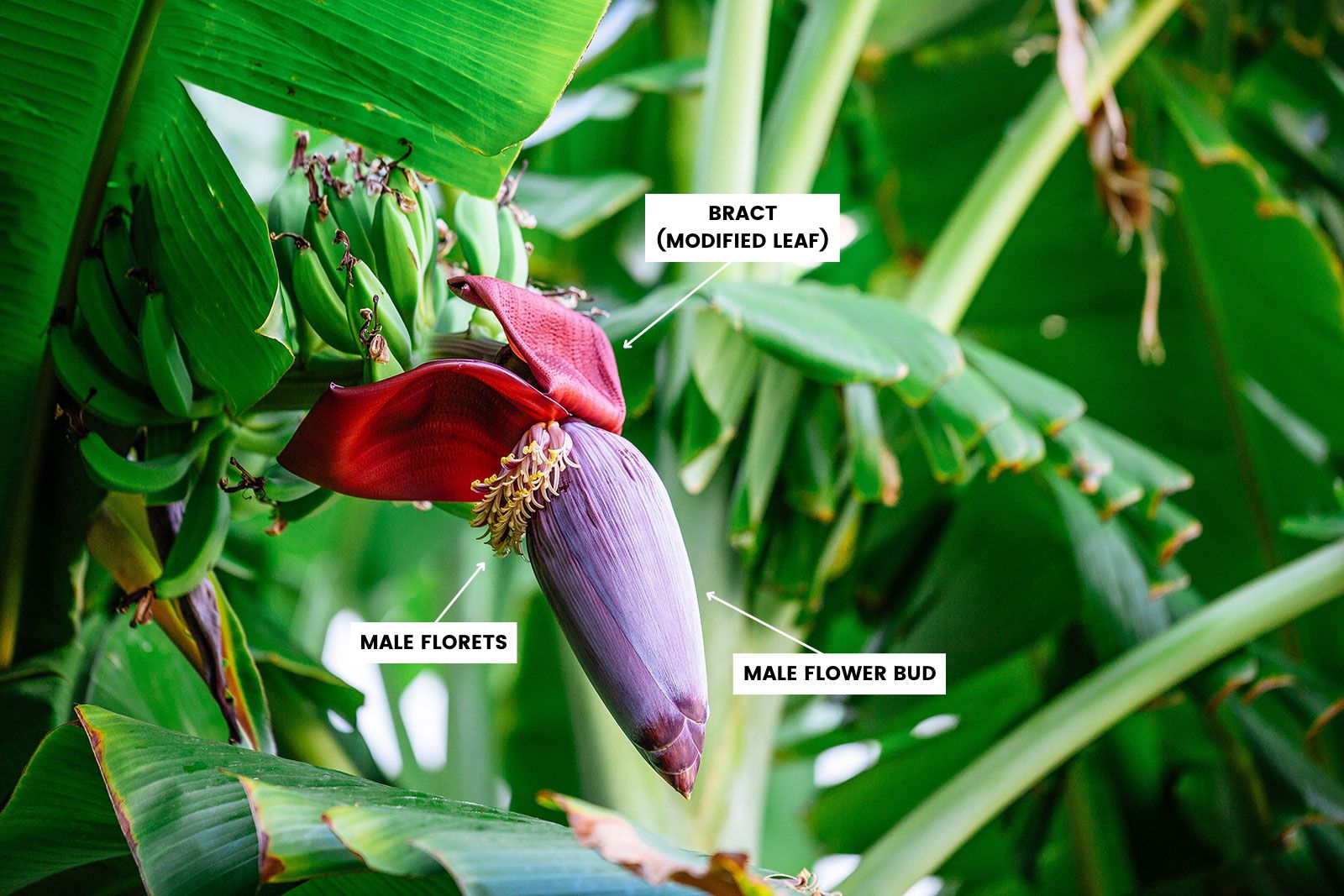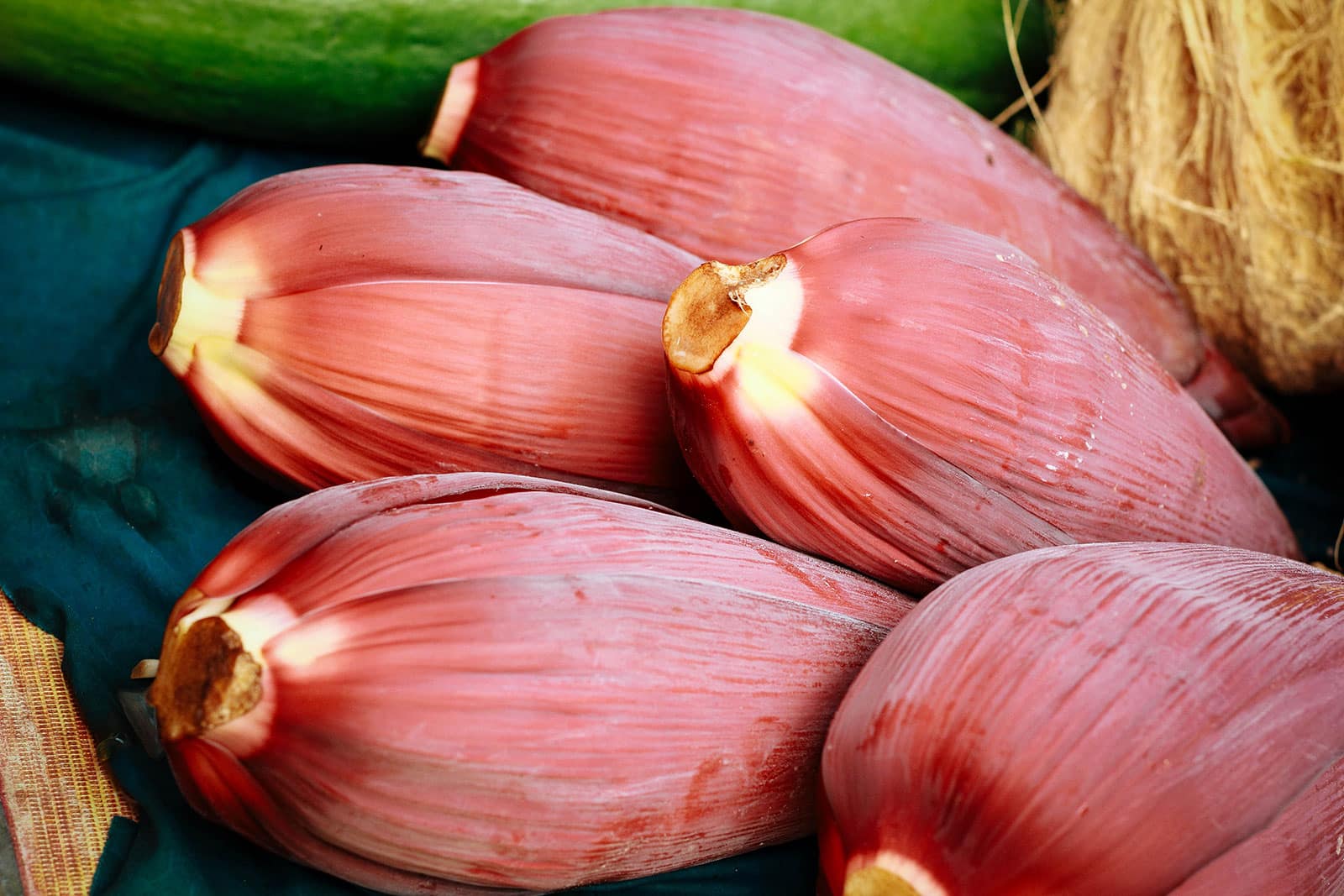Have you ever seen a banana plant in bloom? Its flowers are among the most unusual in the plant kingdom!
A fact that many folks aren’t aware of is that these flowers are also edible and considered a delicacy. Banana flowers are widely used in Southeast Asian cooking, as well as in other parts of the world where banana plants grow.
If you’ve never tried banana flower before, you should. Let’s have a look at what these strange blooms actually are, how to harvest them, and how to prepare them!

What are banana flowers?
Also known as a banana blossom or banana heart, what we call the banana flower is found on both wild and cultivated species of banana plants (Musa).
The large flower bud actually consists of the male part of a banana plant’s bloom, as well as a cluster of dark reddish-purple modified leaves (called bracts) that protect it. The bud is large and teardrop-shaped.
When a banana plant flowers, it produces a long stalk called a rachis, which hangs downward. The flower bud, which can be quite large and weighs up to a pound, dangles at the bottom of this stalk.
Located above it are the female flowers, plus their ovaries: clusters of developing bananas, also called “hands.” (As you might’ve guessed, individual bananas are known as “fingers.”)

For a more detailed look into banana anatomy, check out my other write-up on how and why banana plants are actually herbaceous perennials (and not trees as commonly thought).
While most banana blossoms you’ll find are purple- or maroon-colored, pink and yellow banana blossoms also exist. These flowers are found on ornamental species (such as Musa ornata), wild species (such as Musa velutina), or cold-hardy species (such as Musa basjoo).
While all of their flowers are edible, the plants themselves are not as common (or are grown in climates that are not conducive to flowering), so you don’t see often pink and yellow banana blossoms used in cooking.


Are banana flowers edible?
If you peel away a banana flower’s typical purple-red outer bracts and lighter pink inner bracts, you’ll find a pale, soft core.
As with an artichoke (which these flowers are pretty reminiscent of), the outer bracts of the banana blossom are technically edible, but not worth the trouble. They’re just too tough.
Other parts, however, have a more pleasing texture and can be eaten:
- The pale heart
- The pale inner leaves
- The elongated florets
You’ll find recipes for these different parts of the banana flower wherever in the world banana plants naturally grow. They’re surprisingly versatile, and every culture has its own approach to them!
What do banana flowers taste like?
Surprise: Banana flower hearts don’t taste like banana.
They’re actually kind of bitter, especially the less tender parts, but this bitter flavor is easy enough to eliminate by soaking the flower components in water with some salt and lemon juice.
Once you’ve soaked the banana blossom parts, the heart will have a neutral flavor and soft layered texture. Its taste and mouthfeel are often compared to something like palm hearts (the soft edible core of a palm tree) or bamboo shoots (edible young bamboo sprouts). It’s flaky and very lightly crunchy, and used more like a vegetable than a fruit.
The florets (male flowers) located between the bracts also taste quite mild, although they have somewhat of a sweet and floral aroma.


Health benefits
If you’re looking to learn how to cook with a new, healthy ingredient, then banana flowers are worth adding to your kitchen rotation, especially if you’re already growing banana plants at home.
Related: 11 Vegetables You Grow That You Didn’t Know You Could Eat
Banana flowers provide all the essential amino acids that your body needs. They’re an unexpected superfood: incredibly nutrient dense, low in calories, and high in healthy fiber.
Unlike with banana fruits, their sugar content is almost zero.
Banana flowers offer a potent nutritional profile that includes:
- Plenty of potassium
- Antioxidants (including quercetin, catechin, phenols, saponins, and tannins)
- Vitamin C
- Phosphorus
- Magnesium
- Calcium
- Iron
- Zinc
- Copper
When and how to harvest banana flowers
If you’re lucky enough to have your own banana plant, you can harvest homegrown banana flowers. Don’t worry: You don’t have to sacrifice any unripe banana fruits to get the blossom.
In fact, removing only the flower is said to actually be beneficial, as it prevents the plant from wasting nutrients on it. This energy will instead go to the bananas!
(I should add, however, that in my own garden, I didn’t notice a huge difference between leaving the flower versus cutting it off. I still harvested more than enough bananas, though they probably took a little longer to ripen.)
Banana flowers are ready to harvest once all the new banana fruits have developed (but are still small and green). At this point, the blossom itself will dangle below the bunch of unripe bananas, with an area of bare stem between the two.
Be sure to harvest the flower while it’s still young and small. You don’t want it too old or wrinkled, as the longer it sits on the stem, the less palatable the flower becomes.

You can easily cut the stem that separates the flower and the bananas using large pruning shears or a small garden saw. That’s all there is to picking your very own banana flower, the perfect in-between treat to hold you over until you can harvest the actual banana fruits.
Where to buy
Since most of us don’t have our own banana plantations, we’re stuck having to buy our banana flowers. If you live in an area where banana plants grow, your best bet to find fresh banana flowers is to visit your local (farmers’) market.

If the market option turns out to be a bust, or if you’re outside of the tropics, the next place to look is an Asian (or maybe Latino) grocery store. They sometimes carry fresh banana flowers, or you might be able to find them frozen. There are even some online options to get fresh banana blossoms shipped to you, in case you can’t find them locally!
Online sources for fresh banana flowers:
If all else fails, you can always opt for canned banana flower. A Thai brand called Aroy-D should be relatively easy to find in Asian stores, or you can see if the shop might be willing to order some in for you. Canned banana flower can also be bought online. The taste of fresh is superior, but hey, at least going for canned saves you a good bit of prep work (see below).
When buying fresh banana flower, go for blossoms that feel firm, with outer bracts that look fresh. They shouldn’t look dried, withered, or wrinkled.
Storage tips
Fresh banana flowers don’t store very well, which is why you’ll often see them sold wrapped in plastic. Unwrapped and unrefrigerated flowers will only last on the counter for a day or two, so pop yours in the fridge after buying if you’re not ready to use it yet. This should add another couple days of shelf life.
You can freeze banana flower. The lightly crunchy texture will be lost this way, so using the flower for a salad won’t really be possible anymore after defrosting. However, it’ll still be perfect for a warming curry or some tasty fritters!
How to clean and prepare banana flowers
So, once you’ve obtained your banana flower and are ready to get cookin’, how do you actually disassemble and prepare it? I liken the process to unwrapping a present.
As mentioned, various edible components naturally possess a slight bitter flavor, so you’ll have to take some special measures in order to get it to taste good. Preparing a banana blossom isn’t something you can do on the fly for a meal; just like shelling fava beans, it’s a labor of love and requires patience.
Here’s how you clean and prep a banana blossom:
- Prepare a bowl filled with water, a tablespoon of salt, and one lemon’s worth of juice. Banana hearts brown very quickly, just like banana fruits, which the water will help prevent. It will also neutralize any bitterness.
- Begin peeling back the dark purple bracts (outer leaves). The ones on the outside are too tough to eat. You can save them to use as small bowls and serve the finished dish in, though!
- While peeling the bracts, you will run into elongated, yellow-pink florets. Set them aside. They are edible as well, but they will need some further clean-up in a bit.
- You’ll eventually reach bracts that are light pink or white in color. You can stop peeling at this point.
- Cut off any part of the woody, fibrous stem that might still be attached. Place the pale core in the lemon water until you’re ready to use it.
- To prep the florets, peel them open and remove the stamen plus its white covering petal. This needs to be done for every individual floret, except the very young and fully white ones, so it’s definitely a task I like doing on the sofa while watching TV.
- Place each floret in the salty lemon water, or do as the Indians do and soak them in a mix of water with a splash of buttermilk.
You’re now left with two edible parts. Funny enough, in some cultures, the florets aren’t considered all that interesting, and may be discarded.
In others, the reverse is true: folks aren’t accustomed to using the hearts. We’ll save and use them both!
The core or heart, as I’ll discuss further below, is great for making vegan fried “fish.” The younger and less bitter florets work well in salads, or you can use all of them in a nice stir-fry or curry. Any leftover bitterness won’t be noticeable or bothersome at all this way.
Tip: It might be a good idea to wear some gloves while doing the prep work described here. Touching a banana flower can stain your hands a brown or black color.
Ways to use banana flowers
Usually used as a vegetable, banana flowers can be eaten raw or used for a range of different dishes. How they’re prepared depends mostly on location: curries in Indonesia and India (where it’s called vazhaipoo), salads in Thailand, Vietnam and Cambodia, pies in Brazil, fritters in Uganda. Their flavor is so neutral that they work well for lots of different preparations, since they just soak up the flavor of whatever they’re cooked with.


In the West, banana flower is still a relatively unfamiliar ingredient, although it has been gaining a little bit of popularity. Specifically, it’s being touted as an ideal meat replacement for vegetarian and vegan cooking.
While jackfruit is popular as a chicken substitute, banana blossom has a more layered texture that works well to replace fish. Vegan fish and chips, anyone?
















Helpful, thank you. But the Indian name is not quite right. “India” is a huge place, and in South Indian language, Keralan or Malayalan, it is vaizaphoo. The name of banana flowers in India’s original language is actually Sanskrit, and it’s kadala kusuma; kusuma means flower, and kadala is the banana tree.
Well set out and explained. Very helpful
Thank you!